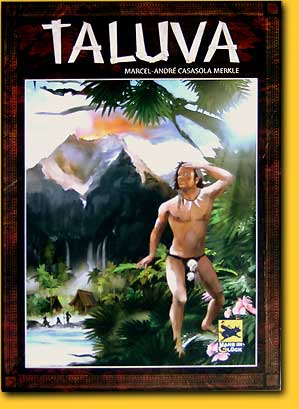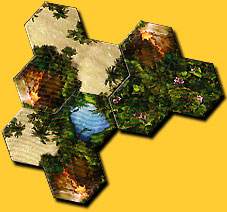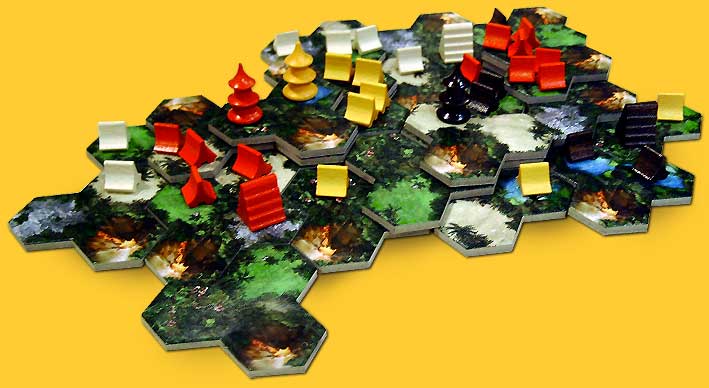Taluva
Author: Marcel-André Casasole Merkle
Publisher: Hans im Glück / Rio Grande Games
Year: 2006
review by

| x |
|
|
|
|
|
|
|
|
|
|
|
|
|
|
|
|
|
|
|
|
|
|
|
|
|
|
|
|
|
|
|
|
|
|
|
|
|
|
|
|
|
|
|
|
|
|
|
|
|
|
 |
Taluva is a fictuous island, probably set in the South Pacific, with a lot of volcanic activity. Despite this disturbing fact, four tribes have decided to settle on this very island. They try to build their huts, temples and towers on suitable locations, thereby attempting to establish a thriving civilisation.
The game board is constructed gradually during the game using land tiles composed of three connected hexagons. Each tile displays one volcano and two other types of land. In a player’s turn, he first places a land tile, and subsequently he places one or more buildings in his colour. A tile may always be placed on ‘ground floor level’ as long as it is adjacent to at least one other tile.
|
| x |
|
|
|
|
|
|
|
|
|
|
|
|
|
|
|
|
|
|
|
|
|
|
|
|
|
|
|
|
|
|
|
|
|
|
|
|
|
|
|
|
|
|
|
|
|
|
|
|
|
|
| It is also possible to build on higher levels, but then more complicated placement rules apply. A tile must be supported completely by other tiles, and it may not partly ‘float’ in the air. In addition, it is not allowed to cover one tile exactly with another tile, but it should overlap with at least two other tiles. This is important for the structural integrity of the island, a phenomenon not unfamiliar to those that used to play with Lego. Furthermore, the volcano on the new tile should be placed on top of another volcano, which severely limits the possibilities. Finally, it is allowed to cover a hut with a land tile; this hut is then removed from the game. It is not, however, allowed to cover temples or towers with land tiles. |
|
 |
| x |
|
|
|
|
|
|
|
|
|
|
|
|
|
|
|
|
|
|
|
|
|
|
|
|
|
|
|
|
|
|
|
|
|
|
|
|
|
|
|
|
|
|
|
|
|
|
|
|
|
|
|
The purpose of this becomes clear in the next aspect of the game: placement of buildings. There are four different options: placing a hut, expanding a village, placing a tower or placing a temple. A hut may be placed on any free hex of a ground floor tile (except volcanoes). But this way, you can place only one hut per turn. It goes a lot quicker with the option ‘expanding a village’. A village is defined as all adjacent hexes that are occupied by buildings of the same colour.
|
| x |
|
|
|
|
|
|
|
|
|
|
|
|
|
|
|
|
|
|
|
|
|
|
|
|
|
|
|
|
|
|
|
|
|
|
|
|
|
|
|
|
|
|
|
|
|
|
|
|
|
|
 |
| x |
|
|
|
|
|
|
|
|
|
|
|
|
|
|
|
|
|
|
|
|
|
|
|
|
|
|
|
|
|
|
|
|
|
|
|
|
|
|
|
|
|
|
|
|
|
|
|
|
|
|
|
When expanding a village, the player selects one of his villages and one type of land (jungle, grass, water, sand or rocks). On all free land hexes of this type that are adjacent to the selected village, he may place huts. On ground floor-hexes, one hut is placed, two huts are placed on a hex on the second level, three huts on the third level et cetera. A temple may be placed on any free hex adjacent to a village. To guarantee enough visitors for the mass, this village has to consist of at least three hexes, and to prevent divine competition only one temple per village is allowed. A tower has to be built on a third level hex because of the nice view, and it has to be adjacent to a village that doesn’t have a tower yet.
The player that manages to place the complete supply of two of his three building types (20 huts, 3 temples, 2 towers) on the board wins the game. If the land tiles are exhausted before this occurs, the player that built the most temples may call himself victorious.
|
 |
|
|
|
|
|
|
|
|
|
|
|
|
|
|
|
|
|
|
|
|
|
|
|
|
|
|
|
|
|
|
|
|
|
|
|
|
|
|
|
|
|
|
|
|
|
|
|
Okay, two out of three building types must be placed on the board to win this game. But which two? You would think that 2 towers and 3 huts can be placed on the board a lot quicker than 20 huts. But since the criteria for the placement of towers and temples are much more difficult to meet, this is not necessarily the case. A ‘third floor’ that is required for building a tower, for example, is not always easy to place. Often, volcanoes are in exactly the wrong position, an opponent has placed a second level tile in such a way that there is no room for a third level, or somebody’s temple, that may not be covered by a land tile, is in the way.
To cover your own huts by land tiles is often an advantage rather than a disadvantage. These huts are removed from the game, so you don’t have to build them again in order to completely finish your hut supply. Remove some huts by covering them with a tile, and then place new huts on exactly the same position helps a lot to quickly exhaust your huts.
|
| x |
|
|
|
|
|
|
|
|
|
|
|
|
|
|
|
|
|
|
|
|
|
|
|
|
|
|
|
|
|
|
|
|
|
|
|
|
|
|
|
|
|
|
|
|
|
|
|
|
|
|
|
The limitation that only one temple and tower may be built per village can be solved with this strategy: remove one hut that connects the temple/tower to the village by covering it with a tile, and then place a new temple/tower in the remainder of the village.
For people that want to prevent other players from covering their huts: using creative land tile placement it is possible to create regions where your huts are safe, for example because there is simply no room for an extra tile.
Vital detail: if you are unable to place a building on the board in your turn, for example because you only have towers and temples left, but there are no locations where they can be built according to the placement rules, you are out of the game! Therefore it is wise to save some huts, that can be placed on any free ground floor hex, for last.
|
|
 |
| x |
|
|
|
|
|
|
|
|
|
|
|
|
|
|
|
|
|
|
|
|
|
|
|
|
|
|
|
|
|
|
|
|
|
|
|
|
|
|
|
|
|
|
|
|
|
|
|
|
|
|
It is not so difficult to figure out what the options of the opponents are, and you can often block or frustrate them. This gives Taluva a high frustration factor, but we’ll just have to deal with that! The wooden buildings look terrific, as do the nice thick land tiles. This gives the game a nice atmosphere, even though that it is actually rather abstract. Add to this the fact that it plays within one hour, and this game can be called a success!
© 2007 Barbara van Vugt
Taluva, Marcel-André Casasola Merkle, Hans im Glück, 2006 - 2 to 4 players, 10 years and up, 45 minutes
|
  |
|
|
|
|
|
|
|
|
|
|
|
|
|
|
|
|
|
|
|
|
|
|
|
|
|
|
|
|
|
|
|
|
|
|
|
|
|
|
|
|
|
|
|
|
|
|
  |
|
|
|
|
|
|
|
|
|
|
|
|
|
|
|
|
|
|
|
|
|
|
|
|
|
|
|
|
|
|
|
|
|
|
|
|
|
|
|
|
|
|
|
|
|
|
  |
|
|
|
|
|
|
|
|
|
|
|
|
|
|
|
|
|
|
|
|
|
|
|
|
|
|
|
|
|
|
|
|
|
|
|
|
|
|
|
|
|
|
|
|
|
|
  |
|
|
|
|
|
|
|
|
|
|
|
|
|
|
|
|
|
|
|
|
|
|
|
|
|
|
|
|
|
|
|
|
|
|
|
|
|
|
|
|
|
|
|
|
|
|
  |
|
|
|
|
|
|
|
|
|
|
|
|
|
|
|
|
|
|
|
|
|
|
|
|
|
|
|
|
|
|
|
|
|
|
|
|
|
|
|
|
|
|
|
|
|
|
  |
|
|
|
|
|
|
|
|
|
|
|
|
|
|
|
|
|
|
|
|
|
|
|
|
|
|
|
|
|
|
|
|
|
|
|
|
|
|
|
|
|
|
|
|
|
|
  |
Beautifully produced game suspects deep play that does not quite fulfills its promise. Best played with two players; with three or four players almost no planning is possible. Prone to 'Analysis Paralysis'. |
| x |
|
|
|
|
| x |
|
|
|
|
|
|
|
|
|
|
|
|
|
|
|
|
|
|
|
|
|
|
|
|
|
|
|
|
|
|
|
|
|
|
|
|
|
|
|
|
|
|
|
|
|
|
|
|
|
|
Also read the  |
|
|
|
|
|
|
|
|
|
|
|
|
|
|
|
|
|
|
|
|
|
|
|
|
|
|
|
|
|
|
|
|
|
|
|
|
| x |
|
|
|
|
|
|
|
|
|
|
|
|
|
|
|
|
|
|
|
|
|
|
|
|
|
|
|
|
|
|
|
|
|
|
|
|
|
|
|
|
|
|
|
|
|
|
|
|
|
|
 |
|
|
|
|
|
|
|
|
|
|
|
|
|
|
|
|
|
|
|
|
|
|
|
|
|
|
|
|
|
|
|
|
|
|
|
|
|
|
|
|
|
|
|
|
|
|
 |
|
|
|
|
|
|
|
|
|
|
|
|
|
|
|
|
|
|
|
|
|
|
|
|
|
|
|
|
|
|
|
|
|
|
|
|
|
|
|
|
|
|
|
|
|
|
| x |
|
|
|
|
|
|
|
|
|
|
|
|
|
|
|
|
|
|
|
|
|
|
|
|
|
|
|
|
|
|
|
|
|
|
|
|
|
|
|
|
|
|
|
|
|
|
|
|
|
|
 |
|
|
|
|
|
|
|
|
|
|
|
|
|
|
|
|
|
|
|
|
|
|
|
|
|
|
|
|
|
|
|
|
|
|
|
|
|
|
 |
|
|
|
|
|
|
|
|
|
|
|
|
|
|
|
|
|
|
|
|
|
|
|
|
|
|
|
|
|
|
|
|
|
|
|
|
|
|
|
|